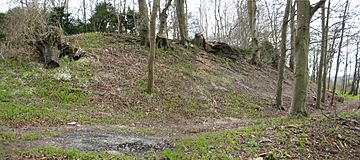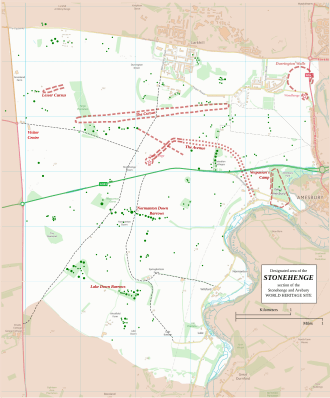Vespasian's Camp facts for kids
| UNESCO World Heritage Site | |
|---|---|

North-western inner bank of Vespasian's Camp
|
|
| Location | Wiltshire, United Kingdom |
| Part of | Stonehenge, Avebury and Associated Sites |
| Criteria | Cultural: (i)(ii)(iii) |
| Inscription | 1986 (10th Session) |
| Extensions | 2008 |
Vespasian's Camp is an ancient hillfort from the Iron Age. It is located near Amesbury in Wiltshire, England. This historic site is less than 2 kilometers (1.2 miles) from Stonehenge, a famous Neolithic and Bronze Age monument. The camp sits on a hill next to the Stonehenge Avenue and borders the River Avon. It is also part of the larger Stonehenge World Heritage Site.
Several other hillforts are found nearby. These include Danebury to the east and Sidbury Hill to the north. Casterley Camp is also to the north, while Yarnbury Castle is to the west. To the south are Figsbury Ring and Old Sarum. Another site, Ogbury Camp, might have been connected to Vespasian's Camp.
Contents
Why is it called Vespasian's Camp?
The name "Vespasian's Camp" was given to these earthworks in the 1500s. This happened when William Camden, a historian from the Elizabethan era, visited the area.
However, there is no proof that the Roman general Vespasian ever came here. He did lead military campaigns in Wessex after the Roman invasion of Britain in 43 CE. But there is no evidence he used this hillfort as a military base.
What does Vespasian's Camp look like?
Vespasian's Camp is quite large. From north to south, it stretches about 730 meters (800 yards). At its widest, the southern end is 374 meters (409 yards) across. The northern end narrows to about 100 meters (109 yards). The entire area covers about 15 hectares (37 acres).
How were the defenses built?
The camp's bank (a raised earth wall) is very wide, up to 40 meters (44 yards). It stands about 6 meters (20 feet) high above the bottom of the ditch. The ditch itself is up to 10 meters (33 feet) wide. Outside the ditch, there is a lower bank called a counterscarp. This makes the total width of the defenses up to 68 meters (74 yards). This design made it a very strong place to defend.
Entrances and unique shape
The hillfort has two original entrances. One is on the north side. The other was likely to the southeast, near where Stonehenge Road now cuts through. Unlike most hillforts, Vespasian's Camp has an unusual arrowhead shape when seen from above. Its southern banks have angled corners. This might have been done to fit the shape of the hill next to the River Avon. This kind of angled corner is not common in hillforts in southern England.
Changes over time
A road was built over the hilltop during the Middle Ages. This road divides the southern part of the site from the rest of the hillfort. In the 1700s, the hillfort was landscaped. This was part of the grounds for Amesbury Abbey, owned by the Marquis of Queensbury. They added a grotto, paths, and planted many trees. Later, in the 1970s, the A303 road was cut through the northern part of the hill.
What have archaeologists found?
Archaeologists have done a lot of research at Vespasian's Camp. They once thought that much of the ancient evidence was lost due to the 18th-century landscaping. However, studies showed that the hillfort mostly escaped these changes.
Early discoveries at Blick Mead
Excavations began in 2005, focusing on an area called Blick Mead. The first finds included tools dating back to the Mesolithic period. Researchers also discovered that what looked like a water feature was actually an ancient spring. This spring might have been part of a seasonal lake long ago.
Evidence of ancient life
Excavations have uncovered a thick layer of domestic waste. This suggests that many people lived on the hill after the banks were built. People lived at this site from about 6250 to 4700 BCE. This is shown by Neolithic pits found near the center. It seems the hill was part of the Stonehenge ritual landscape during the later part of this time.
Important Mesolithic finds
In 2010, more work uncovered a 12-centimeter (4.7-inch) layer of Mesolithic material. This included 10,000 pieces of flint tools and over 300 animal bones. Professor Tim Darvill called this "the most important discovery at Stonehenge in many years." The flint tools were in perfect condition, still sharp enough to cut the excavators' fingers. This layer might extend for hundreds of meters.
Archaeologist Carly Hilts described the tools:
These thousands of tools include an impressive range of implements, from microliths, backed blades (used for making knives, arrows and other composite tools), and burins for working bone and antler, to notched tools (perhaps for cutting sinews or stripping bark to make baskets) and scrapers, as well as cores and knapping debitage representing all stages of the production process. We have also recovered three tranchet axes, a significant haul given that only five had previously been found in the whole Salisbury Plain landscape. Virtually all of these tools are in pristine condition.
One tool was made from slate, a type of rock not found in the area. This slate might have come from North Wales. If so, it shows that hundreds of years before Stonehenge, this place might have been a "special place to gather." Evidence also suggests that the area around the spring was used for large feasts, including eating aurochs (an extinct type of wild cattle). It was also a center for making tools. An unusual Mesolithic "homebase" was found, which was a semi-permanent living site for families.
Vespasian's Camp as a World Heritage Site
The Stonehenge, Avebury and Associated Sites is a UNESCO World Heritage Site (WHS). It is located in Wiltshire, England. This WHS includes two large areas of land, not just one monument. These areas are separated by almost 30 miles (48 kilometers). They were officially recognized as World Heritage Sites in 1986.
What makes this site special?
The WHS contains many large and famous monuments. But it also has a huge number of smaller archaeological sites. Most of these are from the prehistoric period. More than 700 individual archaeological features have been found here. There are 160 separate protected monuments, covering 415 items or features. Vespasian's Camp is located near the eastern edge of the southern part of this important site.
Images for kids



